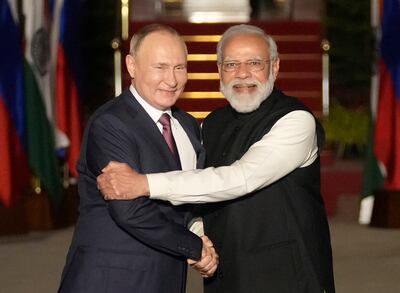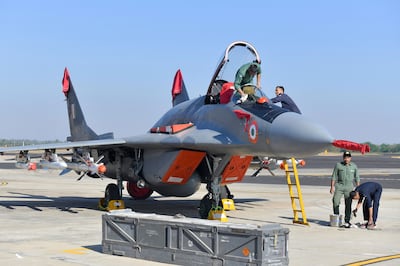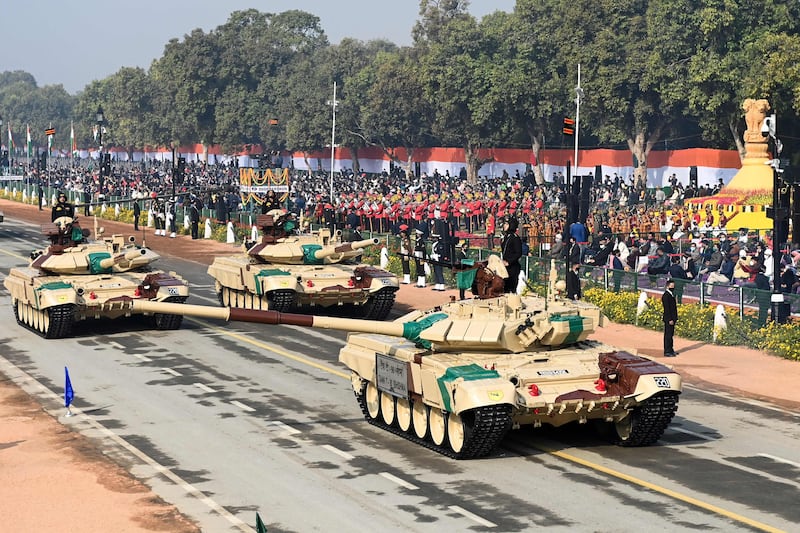India plans to increase its domestic production of military equipment over fears that its main supplier Russia might not be able to meet demand because of the war in Ukraine.
Defence Minister Rajnath Singh announced the decision on Thursday while releasing a list of military equipment that will be produced domestically and no longer imported, including helicopters, tank engines, missiles and airborne early warning systems.
"Our objective is to develop India as a defence manufacturing hub,” Mr Singh said.
India depends on Moscow for about 60 per cent of its defence equipment but Russia's losses in Ukraine are creating uncertainty over future supplies.
Defence Ministry officials say India, with the world’s second-largest army, fourth-largest air force and seventh-largest navy, cannot sustain itself through imports.
The ministry’s website said military orders worth 2,100 billion rupees ($28 billion) are likely to be placed with domestic state-run and private defence manufacturers in the next five years.
New Delhi and Moscow agreed to transfer some weapons manufacturing to India during a visit last year by Russian President Vladimir Putin, said D S Hooda, a retired Indian army general. Imports of helicopters, navy corvettes, tank engines, missiles and airborne early warning systems will cease eventually.
"The requirements of the Russian military itself, with the kind of losses that it is suffering, may mean some of those spares that we need will probably get diverted,” Gen Hooda told Associated Press.
Defence Ministry officials said India might consider purchases from former Soviet republics and Warsaw Pact countries to meet its short-term requirements.
Bulgaria, Poland, Georgia, Kazakhstan and Ukraine could help India with spare supplies for Russian Sukhoi and MiG-29 fighter jets and with upgrading tanks and armoured vehicles, because they have similar Soviet-origin platforms and spares, a ministry official said.
India's Foreign Affairs Minister Subrahmanyam Jaishankar told his British counterpart Liz Truss during her visit to India last week that there was now an emphasis on “made in India” and that "the more collaborative we are, the possibilities of working together are more“.
The two sides discussed ways to strengthen Indo-British defence ties, apparently to reduce India’s strategic dependence on Russia.
India’s Defence Ministry has so far identified a “positive indigenisation list” of more than 300 items, with a timeline for banning imports of these items.
India’s air force has more than 410 Soviet and Russian fighter aircraft with a mix of imported and licence-built platforms, including Su30s, MiG-21s and MiG-29s. All require Russian spares and components. India also has Russian tanks, helicopters, frigates, submarines and missiles.

Rahul Bedi, a defence analyst, said India was awaiting deliveries of Russian missile systems, frigates, an Akula-class nuclear-powered submarine and assault rifles.
Sanctions on Moscow over its war in Ukraine could jeopardise India’s recent $375 million order from the Philippines for BrahMos cruise missiles. Russia’s rocket developer NPO Mashinostroyenia, which formed a joint venture with India’s government-run Defence Research and Development Organisation (DRDO) to design, upgrade and manufacture BrahMos, is responsible for providing the missile system's engines and seekers.
Prime Minister Narendra Modi’s government is pushing for greater self-reliance, but India lacks a strong industrial base for military equipment.
The process of shifting manufacturing of spare parts to India has begun, but Gen Hooda said it was unclear if it could quickly make up for any supply shortfall.
"I would say if you really want to see significant progress it will take at least five years,” he said.
The Defence Ministry has also signed nearly 60 offset contracts worth more than $13 billion by 2027 for purchases of fighter aircraft and weapons from the United States, France, Russia and Israel. The deals require 30 per cent to 50 per cent of the contract value to be returned to India as offsets or re-investments.
An offset involves an obligation by a foreign supplier to buy a certain amount of goods from the importing country as part of the contract. India's government wants part of that money to benefit its defence industry or to allow the country to gain in terms of technology. It involves setting up joint ventures with Indian companies to manufacture defence equipment.
The government announced in the 2022-2023 budget that 68 per cent of all capital defence procurement would be from local manufacturers.

Meanwhile, defence trade with the US increased from nearly zero in 2008 to $15bn in 2019. Major Indian purchases from the United States included long-range maritime patrol aircraft, C-130 transport aircraft, missiles and drones.
In 2020, India announced that foreign companies could invest up to 74 per cent in its defence manufacturing units, up from 49 per cent, without government approval. The aim is to attract foreign companies with advanced technologies to set up factories in India in collaboration with local companies.
India fully opened its defence sector, previously confined to state-run companies, to the private sector in 2001. However, only 110 of the 330 private companies with industrial licences for such manufacturing have begun production, according to the Defence Ministry.
Starting from scratch, the DRDO began trying to develop advanced defence technologies in 1958. It has worked on short-range and long-range Agni and Prithvi missiles, Tejas light combat aircraft, tanks, multi-barrel rocket launchers, air defence systems and a wide range of radar and electronic warfare systems.
The Defence Ministry earmarked 10 billion rupees for procurement from start-ups in 2020-2021.
The government has established two defence industrial corridors, in northern Uttar Pradesh and southern Tamil Nadu states, with investments of $2.7bn by 2024 by state-run and private sector companies.
With reporting from agencies.






